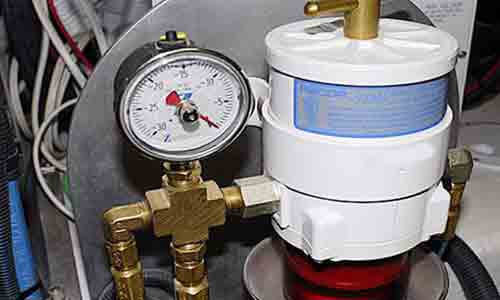
A vacumetro, commonly referred to as a vacuum gauge, serves as a crucial instrument for measuring pressure or vacuum levels within a system.
Widely employed across diverse industries, including automotive, HVAC, and scientific research, it plays a pivotal role in monitoring and maintaining optimal pressure conditions.
Vacumetros are essential tools in various industries and applications. They play a crucial role in measuring and monitoring vacuum levels accurately.
In this article, we will explore what vacumetros are and how they work. We will also delve The Ultimate Guide to Vacumetros Benefits, Types, Applications and Its Work.
Table of Contents
What is Vacumetros?
Vacumetros, also known as vacuum gauges or vacuum meters, are instruments used to measure and quantify the level of vacuum in a given system.
They provide valuable information about the pressure within a vacuum chamber or system, helping users maintain optimal conditions for various processes.
How Do Vacumetros Work?
Vacumetros work on the principle of pressure measurement. They are equipped with sensors that detect changes in pressure and convert them into meaningful readings.
These sensors can be mechanical, electronic, or a combination of both.
Mechanical Vacumetros
Mechanical vacumetros, also called analog or dial gauges, use a system of springs, diaphragms, or Bourdon tubes to measure pressure.
As the pressure changes, these mechanical components move, and the resulting motion is displayed on a calibrated dial.
Electronic Vacumetros
Electronic vacumetros, on the other hand, utilize advanced electronic sensors to measure pressure. These sensors can be based on various technologies such as capacitance, piezoresistance, or thermal conductivity.
The pressure readings are then displayed digitally on a screen.
Read More – GPT66x
Applications of Vacumetros
Vacumetros find applications in a wide range of industries and processes. Some common applications include:
- Vacuum Systems: Vacumetros are used to monitor and control vacuum levels in vacuum systems, ensuring optimal performance and efficiency. They are commonly used in industries such as semiconductor manufacturing, research laboratories, and vacuum packaging.
- HVAC Systems: HVAC systems rely on vacumetros to measure pressure differentials and detect leaks. They help ensure the efficient operation of heating, ventilation, and air conditioning systems.
- Medical and Pharmaceutical Industries: In medical and pharmaceutical industries, vacumetros play a vital role in processes such as freeze drying, vacuum distillation, and vacuum filtration. They help maintain the required vacuum levels for these critical applications.
- Automotive Industry: Vacumetros are used in automotive applications to measure and diagnose engine performance. They help identify issues such as intake manifold leaks, vacuum pump malfunctions, and brake system problems.
- Food Packaging: Vacuum packaging is a common method used to extend the shelf life of food products. Vacumetros are employed to ensure the proper vacuum sealing of food packages, preserving freshness and preventing spoilage.
Types of Vacumetros
There are several types of vacumetros available in the market, each with its own advantages and limitations. Let’s explore some of the commonly used types:
Read More – What is Licoreria Cerca De Mi
-
Thermocouple Vacumetros
Thermocouple vacumetros work based on the principle of thermal conductivity. They measure the rate at which heat is conducted through a gas, which is directly related to the pressure in the vacuum chamber.
-
Capacitance Manometers
Capacitance manometers utilize the change in capacitance between two plates to measure pressure.
As the pressure changes, the distance between the plates varies, leading to a change in capacitance. This change is then converted into pressure readings.
-
Pirani Vacumetros
Pirani vacumetros rely on the principle of thermal conductivity as well. They measure pressure by detecting the cooling effect of gas on a heated wire.
As the pressure decreases, the cooling effect reduces, resulting in a change in resistance that is proportional to the pressure.
-
Penning Vacumetros
Penning vacumetros are commonly used for measuring low vacuum levels. They utilize a magnetic field to ionize gas particles within the vacuum chamber. These ionized particles then generate an electric current that is proportional to the pressure.
-
Ionization Vacumetros
Ionization vacumetros are ideal for measuring high vacuum levels. They work by ionizing gas molecules within the vacuum chamber and measuring the resulting ion current.
The ion current is directly related to the pressure in the system.
Read More – What is Omgflix
Benefits of Using Vacumetros
Using vacumetros offers several benefits in various industries and applications. Some of the key benefits include:
- Accurate Pressure Measurement: Vacumetros provide precise and reliable measurements of vacuum levels, ensuring optimal process control and efficiency.
- Process Optimization: By monitoring vacuum levels, vacumetros help optimize processes, reduce energy consumption, and improve overall performance.
- Early Detection of Issues: Vacumetros can detect leaks, system malfunctions, or abnormal pressure variations, allowing for timely troubleshooting and maintenance.
- Quality Assurance: In industries such as food packaging and pharmaceuticals, vacumetros play a critical role in ensuring product quality and safety.
- Cost Savings: By maintaining optimal vacuum levels, vacumetros help reduce wastage, lower energy costs, and minimize downtime.
Follow Step-by-Step Guide to Use a Vacumetro Effectively
People are buy Vacumetro but don’t know how to use effectively, we are share step-by-step guide to use it, just follow us.
Prepare the System
Ensure the system you are testing is appropriately prepared for vacuum measurement. This may involve sealing openings and ensuring the system is free from leaks.
Connect the Gauge
Connect the vacuum gauge to the system’s pressure port using the appropriate tubing or fittings. Make sure all connections are secure and any inline valves are open.
Take the Reading
Start the system and observe the vacuum gauge reading. Note the stable reading and compare it to the system’s specifications or the expected value for the given application.
Interpret the Results
Use the vacuum level to diagnose issues or confirm the proper operation of the system. If the reading is not as expected, further investigation may be necessary to identify the root cause.
Common Mistakes to Avoid When Using Vacumetros
Avoid these common errors to ensure accurate measurements and safe operation:
Over-Pressurizing the Gauge
Exceeding the maximum rated pressure of the gauge can damage the bourdon tube or cause leaks. Always start the system at low pressure and increase gradually while monitoring the gauge.
Using the Wrong Gauge
Select a vacuum gauge that is specifically designed for the type of pressure you are measuring, whether it is absolute, differential, or relative pressure.
Incorrect Attachment
Improper connection to the system can lead to leaks and inaccurate readings. Always use the correct fittings and verify tight connections.
Choosing the Right Vacumetro: Key Considerations
Selecting an appropriate vacumetro involves thoughtful consideration of various factors. These include the specific application, the required measurement range, the desired level of accuracy, and any additional features needed. Opting for a reputable brand or manufacturer is equally crucial, ensuring access to quality products and reliable customer support.
In essence, a vacumetro emerges as a vital tool in maintaining the health and efficiency of systems across diverse industries, underscoring the importance of informed selection and utilization.
FAQs about Vacumetros
Q. Can Vacumetros measure a variety of gases?
Ans. Depending on their design and specifications, some Vacumetros have the capability to measure different types of gases. To ascertain the gas measurement capabilities of a particular model, it is important to review its features and specifications.
Read More – Eric Weinberger Wife
Q. How user-friendly are Vacumetros for operators?
Ans. Modern Vacumetros are typically designed with user-friendly interfaces and intuitive controls. Their operational simplicity, accompanied by clear instructions, makes them accessible and easy for operators across various industries to use effectively.
Q. What safety precautions should be taken when handling Vacumetros?
Ans. Observing safety measures is paramount. Always adhere to the manufacturer’s safety guidelines, and wear appropriate protective gear when handling Vacumetros. Implementing proper storage and handling practices is essential to ensure safe usage.
Q. To what extent can Vacumetros detect leaks?
Ans. Well-calibrated Vacumetros can efficiently detect leaks by measuring pressure variations. Regular checks using these instruments contribute to the identification and resolution of potential leaks, thereby enhancing system safety and integrity.
Conclusion
Vacumetros are invaluable tools for measuring and monitoring vacuum levels in various industries and applications. They provide accurate and reliable pressure readings, helping optimize processes, detect issues, and ensure product quality.
With different types of vacumetros available, users can choose the most suitable option for their specific needs. By leveraging the benefits of vacumetros, businesses can enhance efficiency, reduce costs, and maintain a competitive edge.
Follow – https://sggreek.com for More Updates


